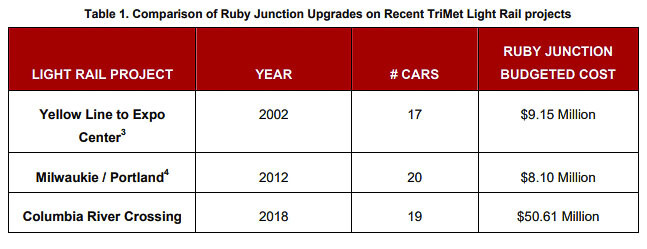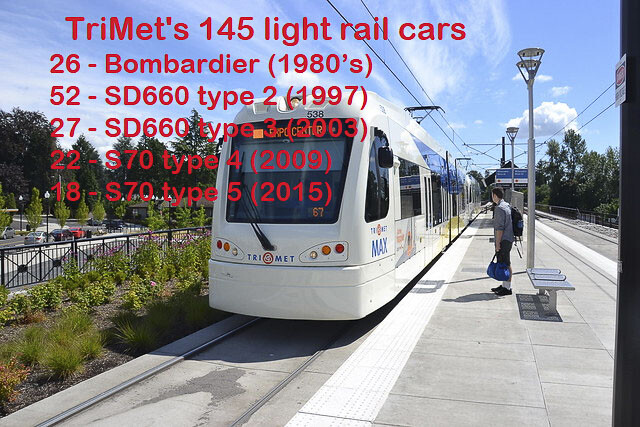TriMet seeks others to pay as part of Interstate Bridge Replacement
John Ley
For Clark County Today
It has been revealed that TriMet’s preliminary operating cost for the light rail extension into Vancouver will be $21.6 million per year, according to a cost estimate developed by the Interstate Bridge Replacement Program (IBR). The IBR has chosen a 3-mile extension of the MAX Yellow Line as its preferred mode of high capacity transit for the project. The IBR finance plan indicates the transit component could cost between $1.3 billion and $1.99 billion,
In June last year, TriMet’s J.C. Vanetta told the 16-member Bi-state Bridge Committee of Washington and Oregon legislators that they needed new revenues (taxes) from both states to cover operations of the light rail extension. “TriMet will not be responsible for O&M costs resulting from the extension into Vancouver,” he said.
“Currently, as the project has probably told all of you that conceptual capital costs for the entire IBR program is $3.2 to $4.8 billion,” Vanetta said.. “This includes about $1 billion to $1.3 billion associated with the transit elements.” Six months later, the cost projections exploded to $5 to $7.5 billion for the entire IBR project and up to $2 billion for the MAX extension..
Clark County Council Chair Karen Bowerman said the following a few days later. “Since TriMet is not responsible for any light rail O&M costs in Vancouver, who will pay for that?” She would not support Clark County taxpayer funds being used for TriMet..
C-TRAN CEO Shawn Donaghy has stated multiple times that his agency will not be paying for the light rail operations and maintenance (O&M) costs. “To date, there has not been an ask or identified plan of action by IBR as it relates to their recommendation regarding how or who should cover the operating costs (either completely or shared),” Donaghy said in an email.
They further clarified via a Public Records Request response. “C-TRAN’s position has consistently been that C-TRAN will not be responsible for costs related to operations and maintenance of light rail in Clark County, including any park and ride facilities that may be constructed as part of the project. C-TRAN CEO Shawn Donaghy has stated this publicly on numerous occasions, and the C-TRAN Board of Directors included this among its conditions for approval of the modified LPA (locally preferred alternative) in 2022.”
The $21.6 million TriMet is seeking would equal about $7.2 million per mile. In FY 2022, TriMet spent $128.1 million on operations for its entire 60-mile MAX light rail system. That equals about $2.1 million per mile. Why is the IBR seeking over triple that amount?
The recently passed 2024 TriMet budget contains a 10-year financial projection. In it, TriMet will burn through over $500 million of its cash reserves.
Economist Joe Cortright said operating funds must be identified prior to getting federal money for the capital costs of transit. “Neither C-TRAN nor TriMet is willing to commit any funds of their own to this project,” he said. “This is especially important because the USDOT (Federal Transit Administration) won’t fund the capital construction of a project that has no source of operating funds.
“TriMet’s board considered their endorsement of the project last Wednesday,” Cortright continued. “They voted to go ahead, provided somebody else pays for its entire costs.”
Nineteen new light rail cars & maintenance facility
TriMet officials responded to an earlier Clark County Today information request and shared that they are hoping to acquire 19 new light rail vehicles as part of the IBR project. Additionally, during the recent Vancouver open house, it was noted they are proposing an expansion of their Ruby Junction (Gresham) maintenance facility.
“The extension of MAX Yellow Line across the Columbia River would require the purchase of 19 additional light rail vehicles, and thus the expansion of the Ruby Junction facility for their storage and maintenance,” said TriMet’s Tyler Graf. “At this point in the project, we do not have a number for either the bays or length of track.” He did not provide a cost estimate for either the new light rail vehicles or the expansion of Ruby Junction.
Currently, TriMet is building a 10-mile extension of the Red Line from Beaverton to Hillsboro. It has ordered four new light rail vehicles to operate this extension.
Also in the IBR plan is a separate TriMet overnight facility on the south side of the Expo Center. It would include a building and tracks to overnight trains closer to the end of the line. Apparently it is an option under consideration, but if built, would still require an expansion of Ruby Junction.
Five days after Vanetta briefed legislators last year, the TriMet Board of Directors approved “a number of significant conditions that must be satisfactorily addressed prior to Program completion.” Those conditions included the 2013 significant expansion of the TriMet Ruby Junction facility in Gresham, an upgrade to Portland’s Steel Bridge, and issues regarding the proposed Vancouver waterfront light rail station.
The Ruby Junction facility was a contentious component of the failed Columbia River Crossing (CRC) effort. One news report at the time indicated the requested funds were five to six times previous light rail expansions. Acuity Forensics issued a 12-page white paper analysis of the Ruby Junction and Steel Bridge expenditures as part of the failed CRC.
In 2012, forensic accountant Tiffany Couch found $50.6 million was budgeted for TriMet’s Ruby Junction light-rail maintenance facility, 16 miles from the CRC site. The reason? So Ruby Junction can handle 19 additional light-rail cars for a new Vancouver line. Couch noted the Milwaukie MAX expansion will add 20 cars but only includes $8.1 million for Ruby Junction. Couch called the CRC money padded on for TriMet’s facility significant enough to be classified as an irregularity.

When TriMet created MAX, it ordered 26 vehicles for the 15-mile Blue Line from Gresham to downtown Portland. In creating subsequent new lines, TriMet ordered 17 cars for the 6-mile Yellow Line, and 20 cars for the7-mile Milwaukie Green Line. TriMet requested 19 vehicles for the CRC extension of the Yellow Line a decade ago.
TriMet has 145 light rail vehicles. It is presently replacing the oldest vehicles, ordered back in the 1980s. The replacement of all 26 train cars is expected by 2026. TriMet recently issued an additional request to the federal government seeking funding for the replacement of the vehicles acquired in the 1990s.
TriMet’s light rail costs
The transit agency published its FY 2022 financial data earlier this year. The pandemic lockdowns were devastating to ridership, which is slowly returning. The recently passed TriMet budget included a 10-year financial projection. The transit agency will burn through just over $500 million of its cash reserves over the next decade.
Passenger fares only pay for 12 percent of TriMet bus system operating costs and 15 percent of MAX light rail operating costs. Taxes from local businesses and property owners, plus allocations from the Oregon legislature cover the rest of operating costs.
TriMet’s MAX light rail operating costs were $133.7 million in FY 2021 and $128.1 million in FY 2022..With a 60-mile light rail system, the $21.6 million to operate the IBR light rail extension would equal nearly 17 percent of TriMet’s entire operating costs for light rail.
The MAX operating cost per mile last year was $2.15 million. Therefore the three-mile extension into Vancouver should cost no more than about $6 million annually to operate. TriMet is seeking $21.6 million, over three times as much for the extension of an existing line..
TriMet is now asking others to pay $21.6 million a year towards its operating costs, in addition to having others pay to replace old light rail train vehicles. The IBR Finance Plan released in March indicates “at least $300 million (15 percent) of the combined $2 billion contribution from both states needs to be eligible for transit expenditures.” The IBR program reports this is needed to meet federal matching requirements. The FTA will pay no more than 50 percent of the capital cost of an approved transit project.
About 23 percent of MAX vehicle hours (68,628) are not in revenue service. That is a lot of “out of service” trains moving around.
In 2020, Portland metro area voters rejected spending $2.9 billion for a proposed new Southwest Corridor MAX line to Tualatin. TriMet told the FTA that it planned to purchase 36 new light rail vehicles as part of the 12-mile project.
How much do TriMet officials expect Washington taxpayers to payTriMet for both capital and operating costs via the IBR? C-TRAN says it won’t be the one paying.





